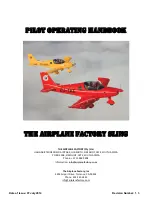
26
27
Reverse Take off
The preparation is the same as to forward take off. But this time you have to turn
towards the canopy. During the turn lift the hand which is turning away from the
paramotor wing with the risers above your head. Now you can inflate the glider with
the red (A) risers. Push the risers up and let them go when the canopy is over your
head. If necessary use the brakes gently. Turn out and begin the start run.
Attention: check to turn out to the right side. Example you turned with your left
side to the glider you have to turn out with your left side to the paramotor wing.
Otherwise you will have made a 360 degree turn and all your risers are twisted.
In case of strong wind it could be necessary to make some steps towards the canopy
during inflation. This take off method can be used even with little wind.
Takeoff with paratrike
For launching with a paratrike you need a long flat runway. A second person could
be helpful. This helper could push your trike to inflate the canopy whilst engine idling.
If the paramotor wing is rising let the engine accelerate more and pull the paramotor
wing up slowly. After visual check accelerate until you take off.
Sol Paragliders does not recommend using the engine force to inflate the
paramotor wing.
Climbing
Avoid a take-off with full throttle, the canopy is in a position a little behind the
paramotor, the overdue on the commands during take-off could eventually cause a
stall or worse an accident.
Avoid unnecessary risks and always fly with a speed reserve.
Depending on the power unit geometry, it is possible that during the flight you will
notice a propeller torque (known as P-factor). It will try to turn you around, so counter-
steer with a brake and trimmer set. Open the trimmer of the right side if the canopy
is turning right and open the trimmer of the left side if the canopy is turning left.
Turns
The Flexus 2 is very sensitive, responding instantly to turn commands. Leveled turns can
be achieved with the shifting of weight on the risers with minimum altitude loss.
A combination of weight shifting and breaking technique is the most efficient way
of executing turns in any situation. The given brake utilized determines the radius of
turns. By activating the brakes on the outside edge of the turns, as well as applying
maximum weight shifting on the risers, the efficiency and resistance to collapse in
turbulences (at the edge of thermals) is increased.
In case it becomes necessary to perform turns in a constrained space we recommend
to release the outside brake in the given turn and pull a little more the brake on the
inside of the turn. The paramotor wing glides best when no brakes are applied.
The pilot can use the double command to make more closed turns.
By pulling either brake too strongly or suddenly, there is a danger of creating a
negative spiral!
Содержание Flexus 2
Страница 1: ...Manual DGAC Version 2 3 2021 ...














































